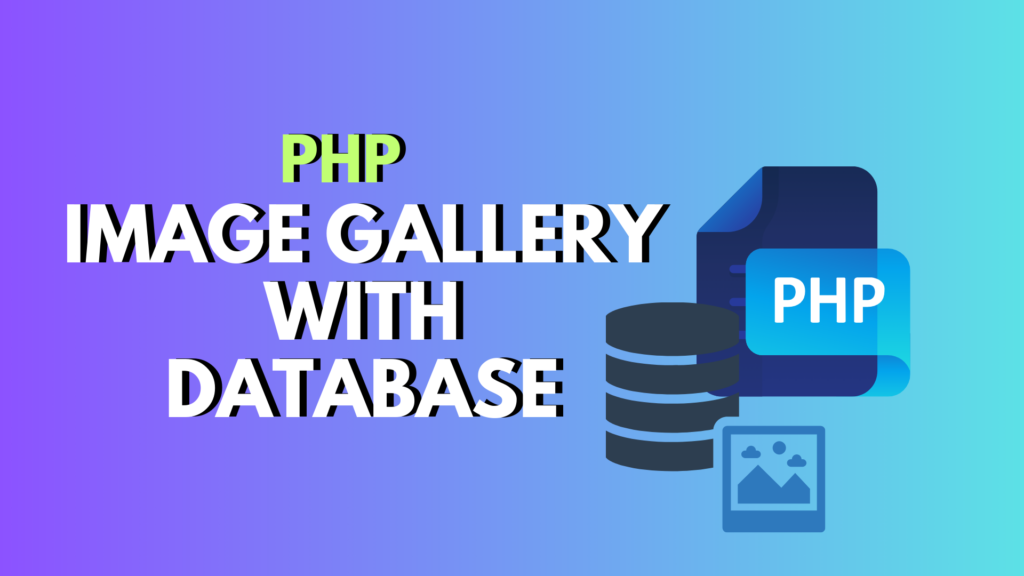
Introduction to PHP-Based Photo Albums
What is a PHP Photo Album?
A PHP photo album is a web application that allows users to upload, organize, and display images dynamically using PHP and other web technologies. Unlike static HTML galleries, PHP-based albums can interact with a database to store metadata, categorize images, and enable powerful features like user uploads, search, and secure access.
Why Choose PHP for Photo Galleries?
PHP remains a top choice for developing image gallery systems due to:
- Widespread Hosting Support: Most shared and cloud hosts support PHP.
- Database Integration: Easily integrates with MySQL or MariaDB.
- Server-Side Image Handling: Use built-in functions for resizing, compressing, or watermarking images.
- Open Source Ecosystem: Tons of free scripts and plugins available.
PHP allows you to customize every aspect of your album—functionality, design, and security.
Core Features of a Good Photo Album Script
A well-designed PHP photo album should include:
Image Upload and Management
- Support for drag-and-drop uploads
- File type validation
- Image compression and resizing
Responsive and Mobile-Friendly Layout
- Adapts to screens of all sizes
- Uses frameworks like Bootstrap or Tailwind for grid layout
Album Categories and Tags
- Organize images into albums or events
- Add tags, descriptions, and custom fields
Admin Dashboard for Easy Control
- Create, edit, or delete albums
- Manage user access and image permissions
- Monitor upload logs and analytics
Setting Up Your PHP Environment
Required Tools (PHP, MySQL, Apache)
You’ll need:
- PHP (7.4 or higher)
- MySQL or MariaDB for storage
- Apache or Nginx web server
Installing XAMPP or WAMP for Local Testing
XAMPP (for all platforms) or WAMP (Windows) bundles PHP, MySQL, and Apache. Download from:
Once installed, place your project in the htdocs folder (XAMPP) and access it via http://localhost.
File Structure for a Photo Album Project
/photo-album
│
├── /uploads # Image storage
├── /admin # Admin panel
├── index.php # Homepage
├── upload.php # Upload handler
├── config.php # DB config
└── style.css # Layout
Organizing files this way keeps your project scalable and secure.
Creating a Basic PHP Photo Album from Scratch
HTML and CSS Template Design
Start with a basic grid layout using HTML5 and CSS:
<div class="gallery">
<?php foreach($images as $img): ?>
<img src="uploads/<?= $img['filename'] ?>" alt="<?= $img['title'] ?>">
<?php endforeach; ?>
</div>
Use flexbox or grid CSS for styling.
Uploading and Displaying Images
upload.php:
$target = "uploads/" . basename($_FILES['image']['name']);
move_uploaded_file($_FILES['image']['tmp_name'], $target);
Save image info into a MySQL database for dynamic loading.
Creating Dynamic Albums with MySQL
Schema:
CREATE TABLE albums (
id INT AUTO_INCREMENT PRIMARY KEY,
title VARCHAR(100),
description TEXT
);
CREATE TABLE images (
id INT AUTO_INCREMENT PRIMARY KEY,
album_id INT,
filename VARCHAR(255),
uploaded_at TIMESTAMP DEFAULT CURRENT_TIMESTAMP
);
Use joins to display images by album.
Using PHP with JavaScript for Enhanced Interactivity
Adding Image Lightbox or Carousel
Use libraries like Lightbox2 or Slick Slider. Load scripts and initialize via JavaScript:
lightbox.option({
'resizeDuration': 200,
'wrapAround': true
})
AJAX Image Upload Without Page Reload
$("#uploadForm").submit(function(e){
e.preventDefault();
$.ajax({
url: 'upload.php',
type: 'POST',
data: new FormData(this),
contentType: false,
processData: false,
success: function(data){
alert("Image uploaded!");
}
});
});
Top 5 Open Source PHP Photo Album Scripts
1. Piwigo
- Community-driven, actively maintained
- Albums, user roles, and extensions
- https://piwigo.org
2. Gallery3
- Clean UI, good for photographers
- Lightweight and minimal dependencies
3. Coppermine
- Feature-rich with themes, plugins, comments
- Used by hobbyists and pros alike
4. Chevereto (Free Version)
- Sleek interface for personal image hosting
- Drag-and-drop uploads and user login
5. TinyWebGallery
- Full gallery solution with Flash and HTML5 options
- Built-in slideshow and watermarking
Continuing the article from where we left off 👇🏻
Customizing Your Photo Album Design
Using Bootstrap or Tailwind with PHP
Integrating front-end frameworks like Bootstrap or Tailwind CSS enhances your gallery’s responsiveness and style without needing advanced CSS skills.
Example: Bootstrap grid layout for images:
<div class="row">
<?php foreach($images as $img): ?>
<div class="col-md-3 mb-3">
<img src="uploads/<?= $img['filename'] ?>" class="img-fluid rounded">
</div>
<?php endforeach; ?>
</div>
Tailwind offers utility-first styling and makes custom layouts easier with fewer lines of code.
Theme Switching Options
Let users or admins choose different themes:
- Store selected theme in the session or database
- Load CSS conditionally based on the theme
Example:
if ($_SESSION['theme'] == 'dark') {
echo '<link rel="stylesheet" href="dark.css">';
} else {
echo '<link rel="stylesheet" href="light.css">';
}
Image Effects with CSS and JS
Enhance visuals using:
- Hover zoom effects
- Grayscale-to-color transitions
- Fade-in animations
.gallery img:hover {
transform: scale(1.1);
transition: all 0.3s ease-in-out;
}
Implementing User Authentication for Private Albums
Login System with PHP Sessions
Create a secure login system using PHP sessions:
session_start();
if ($_POST['username'] == 'admin' && $_POST['password'] == '1234') {
$_SESSION['user'] = 'admin';
header('Location: dashboard.php');
}
Restricting Album Access by User Role
Add a private flag to albums and restrict viewing:
if ($album['private'] && $_SESSION['user'] != 'admin') {
die("Access denied");
}
Use roles (admin, member, guest) to control access levels.
Adding Pagination and Search Functionality
Paginating Large Albums
Use LIMIT and OFFSET in SQL queries to display limited results per page:
SELECT * FROM images LIMIT 10 OFFSET 0
Generate navigation links dynamically based on total image count.
Search by Tags, Titles, or Descriptions
Add a search bar that filters images:
$search = $_GET['q'];
$sql = "SELECT * FROM images WHERE title LIKE '%$search%' OR tags LIKE '%$search%'";
Sanitize input to prevent SQL injection using prepared statements.
Securing Your PHP Photo Album Website
File Upload Security Measures
Prevent risky uploads by:
- Limiting file types (
.jpg,.png,.gif) - Renaming uploaded files
- Storing images outside public root when possible
$allowed_types = ['image/jpeg', 'image/png'];
if (!in_array($_FILES['image']['type'], $allowed_types)) {
die("Invalid file type.");
}
Input Sanitization and Validation
Always sanitize user input using filter_input() or libraries like HTMLPurifier.
Protecting User Sessions
- Use HTTPS
- Regenerate session IDs after login
- Set session expiration time
Integrating Cloud Storage or CDN
Storing Images on AWS S3 or Google Cloud
Instead of local storage, use cloud buckets for scalability and performance.
- Use AWS SDK for PHP to upload to S3.
- Configure image permissions and paths accordingly.
Using Cloudflare for Faster Image Delivery
Cloudflare caches your images and delivers them from the nearest edge server, boosting performance significantly—especially for global audiences.
Creating an Admin Dashboard for Photo Management
Add/Edit/Delete Albums
Create simple forms to manage albums in the backend:
- Input fields for title, description
- Image preview section
- Delete confirmation modals
Bulk Image Upload
Allow admins to select and upload multiple files at once using HTML5 multiple attribute:
<input type="file" name="images[]" multiple>
Loop through $_FILES['images'] in PHP to process each upload.
Album Statistics and Logs
Display:
- Number of views
- Number of images
- Upload history
- Error logs
Store logs in a separate DB table or as flat files.
Real-World Use Cases of PHP Photo Albums
Photographer Portfolio Websites
Showcase photo collections with categories like portraits, events, nature, and more—often paired with blog entries or testimonials.
Event and Wedding Galleries
Clients can browse and download images from their events. Password protection ensures privacy.
Internal Company Archives
Store and manage company event photos, product shots, or marketing assets. Admin panel ensures only authorized staff can modify content.
Common Issues and Debugging Tips
File Upload Errors
Check:
- PHP file size limits (
upload_max_filesize) - Folder write permissions
- File type validation logic
Permissions and Path Problems
Use chmod to give write permissions to upload directories. Always verify relative vs absolute paths in PHP.
Database Connection Troubles
Ensure credentials and hostnames are correct. Use PDO or mysqli with error handling:
try {
$pdo = new PDO($dsn, $user, $pass);
} catch (PDOException $e) {
die("DB Error: " . $e->getMessage());
}
Frequently Asked Questions (FAQs)
How do I create a dynamic photo album in PHP?
Use a combination of PHP, MySQL, and HTML to display images stored in a database. Upload forms and album tables allow for dynamic display and filtering.
Can I make my PHP photo album mobile-friendly?
Yes. Use responsive CSS frameworks like Bootstrap or Tailwind and set images to width: 100% for fluid resizing.
What is the best free PHP photo gallery script?
Piwigo is highly recommended for its community, extensibility, and active development. Coppermine and Chevereto (free version) are also solid choices.
Store images outside the web root and serve them through PHP scripts that check user permissions before outputting content.
How can I allow users to upload photos?
Implement a front-end upload form and secure back-end script to handle the file. Use user authentication to control who can upload.
Does PHP support image compression for uploads?
Yes. Use the GD or Imagick library to compress, resize, or watermark images after upload.
Conclusion
Final Thoughts and Next Steps
Creating a PHP photo album is an excellent way to showcase images dynamically while giving users and admins powerful tools to manage and view content. From small personal galleries to large-scale photography portfolios or private corporate albums, PHP offers endless customization options.
To take your gallery further:
- Add watermarking and download options
- Integrate third-party image hosting
- Use REST APIs for mobile app integration
With strong foundations and a little creativity, your PHP-powered photo album can be both beautiful and robust.




0 Comments